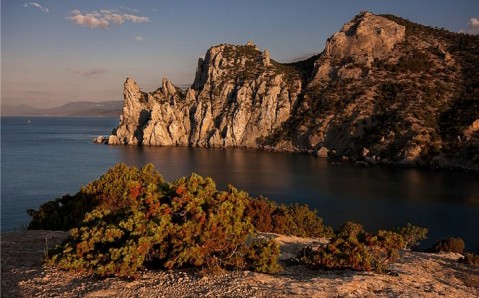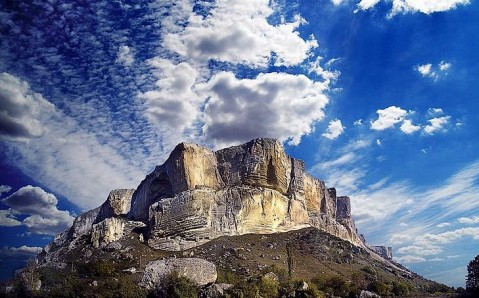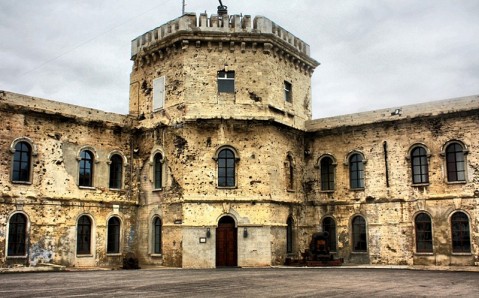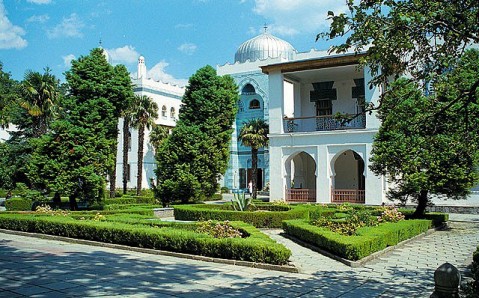Mount Karaul-Oba
•
Sudak (128 km.)
Mount Karaul-Oba
•
Sudak (128 km.)
The mount Karaul-Oba is a part of the nature reserve Novyi Svit and is reckoned among many unique natural wonders of Sudak’s surroundings. This antique 341-meter-high coral reef with picturesque slopes, covered with juniper and relict pines, towers over resort settlements Vesyoloye and Novyi Svit as a protective shield. Karaul-Oba is interesting for original natural and archeological attractions,
Kachi Kalyon
•
Bakhchysarai (70 km.)
Kachi Kalyon
•
Bakhchysarai (70 km.)
Kachi Kalyon is a medieval cave monastery, situated in the picturesque Kachinskaya Valley in Bakhchysarai surroundings. It stands on the slope of the giant 140-meter-high ivy-covered rock mass, whose bizarre shape resembles a gigantic ship's nose, rushing down the river Kacha. It is often referred to as the Crusade Ship, because of the huge cross, ‘drawn’ on the face of the rock by nature.
Natural
Mount Koshka
•
Yalta (102 km.)
Mount Koshka
•
Yalta (102 km.)
The picturesque Mount Koshka towers above the resort settlement Simeiz, 15 kilometers away from Yalta. It is reckoned among the most beautiful landscape monuments on the Southern Coast of Crimea. ‘Koshka’ is a Russian word for ‘cat’ and mountain’s silhouette is indeed reminiscent of an elegant cat that bends before a jump. But in fact, its current name is nothing but reconsidered in Russian way va
Eski Kermen
•
Bakhchysarai (73 km.)
Eski Kermen
•
Bakhchysarai (73 km.)
The ancient Eski Kermen is situated on the mountain tableland difficult of access. It is one of the oldest and the most picturesque cave towns in Bakhchysarai surroundings. Due to its imposing age and rare authenticity that allows feeling the atmosphere of antiquity in full, the medieval settlement, whose name means Old Fortress in Tatar, is reckoned among the most frequently visited archeological
Foros’s Church (the Church of the Resurrection)
•
Yalta (95 km.)
Foros’s Church (the Church of the Resurrection)
•
Yalta (95 km.)
Foros is associated with elegant temple, situated on the 400-meter-high cliff and soaring above the sea, probably more often than with its splendid beaches, warm sea and amazing sceneries. It is the Church of the Resurrection, resort’s main symbol and genuine adornment of the Southern Coast of Crimea.
The magnificent temple in Byzantine style was raised in 1892, thanks to the merchant and Maecenas
Mikhailovskaya Battery
•
Sevastopol (65 km.)
Mikhailovskaya Battery
•
Sevastopol (65 km.)
Situated on the northern side of the Sevastopol bay, the large-scale fortification with multitude of loophole windows is clearly seen from the city quay. It is the Mikhailovskaya Battery, one of Sevastopol Fortress’s forts that survived until now. This object of huge historical importance has become the symbol of the hero city. Today, majestic ravelin’s premises are turned into original exhibition
Dulber Palace
•
Yalta (104 km.)
Dulber Palace
•
Yalta (104 km.)
The elegant Dulber Palace, built in the late 19th century for the Prince Pyotr Nikolayevich, an uncle of the last Russian Imperator Nicholas II, is one of the brightest architectural gems at the Southern Coast of Crimea. Its fabulous snow-white asymmetric building with silver cupolas and elegant turrets noticeably stands out against a background of fantastic Crimean Mountains’ sceneries and is rec
Uchan-Su Waterfall
•
Yalta (98 km.)
Uchan-Su Waterfall
•
Yalta (98 km.)
Yalta’s picturesque surroundings conceal many wonders of nature: their concentration per square meter rolls over limit, exceeding all thinkable and unthinkable norms. One of them is majestic waterfall Uchan-Su, located on the southern slope of the beautiful Ai-Petri Mountain. Its name means flying water in Crimean Tatar. It is the highest waterfall not only in Crimea, but in the whole Ukraine as w
Chokrak Lake
•
Kerch (231 km.)
Chokrak Lake
•
Kerch (231 km.)
The salty Chokrak Lake, situated on the Kerch Peninsula near the village Kurortnoye, is a true natural wonder. It is notable for its unique curative mud, whose composition has no analogues in the world. The mud is formed on the lake’s bottom by hydrosulfuric springs and mud volcanoes, as well as by algae and microorganisms from the sea water, which feeds the lake through a narrow sand and shell ba

 Crimea
Crimea









